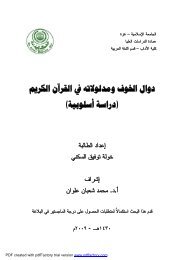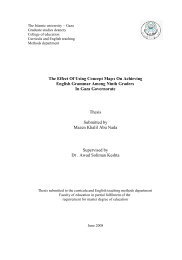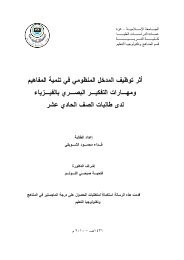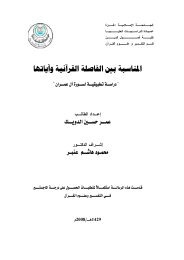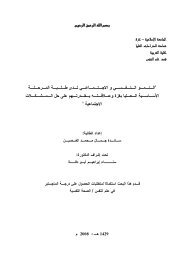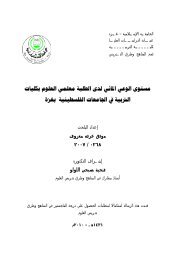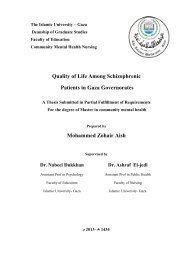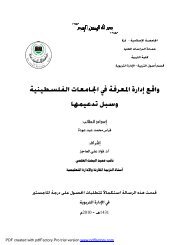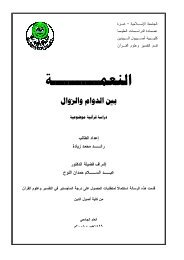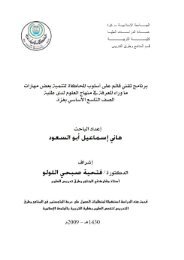developing a model for integrating safety, quality and productivity in ...
developing a model for integrating safety, quality and productivity in ...
developing a model for integrating safety, quality and productivity in ...
You also want an ePaper? Increase the reach of your titles
YUMPU automatically turns print PDFs into web optimized ePapers that Google loves.
safer. A new worker when oriented will per<strong>for</strong>m tasks of project of good <strong>quality</strong> s<strong>in</strong>cehe has been shown risks <strong>and</strong> hazards associated with tasks."Worker work<strong>in</strong>g with same crew (friends relatives, etc.) <strong>in</strong>creases <strong>quality</strong>,<strong>productivity</strong>, <strong>and</strong> <strong>safety</strong>" factor was ranked <strong>in</strong> the fourth position among workmanshipgroup with RII = 0.717 <strong>and</strong> was ranked <strong>in</strong> the 23 rd position among all groups factorsof <strong>quality</strong>. This result <strong>in</strong>dicates workers work<strong>in</strong>g with same crew either friends orrelatives, feel more com<strong>for</strong>table than with new crews. This com<strong>for</strong>table feel<strong>in</strong>gmotivates workers to collaborate <strong>and</strong> cooperate on resolv<strong>in</strong>g any k<strong>in</strong>d of problems <strong>and</strong>thus elim<strong>in</strong>ate unexpected hazards. Same crew workers would produce more <strong>quality</strong>work s<strong>in</strong>ce they would collaborate on per<strong>for</strong>m<strong>in</strong>g tasks effectively. Same crewworkers might help solv<strong>in</strong>g each other's personal problems thus reduc<strong>in</strong>g mentaldispersion which leads to more accidents, less <strong>quality</strong>, <strong>and</strong> less <strong>productivity</strong>."Absence of one or more of workers results <strong>in</strong> replacement of new worker temporarilywhich decreases <strong>quality</strong> <strong>and</strong> <strong>in</strong>creases accidents" factor was ranked <strong>in</strong> the fifthposition among workmanship group with RII = 0.697 <strong>and</strong> was ranked <strong>in</strong> the 29 thposition among all groups factors of <strong>quality</strong>. This result is relatively relevant to theabove mentioned paragraph of same crews. This result illustrates that when a workeris absent he is replaced by a new one who might not be familiar to crew. Thus, <strong>in</strong>order to get familiar to the crew the new worker needs time dur<strong>in</strong>g which he might beexposed to hazards. The mechanism of task per<strong>for</strong>mance would be <strong>in</strong>consistent s<strong>in</strong>cea new worker is <strong>in</strong>volved which means that crew would need more time to make thenew worker cope with their <strong>productivity</strong> <strong>and</strong> <strong>quality</strong> <strong>in</strong> addition to <strong>safety</strong>."Lack of sufficient workers decreases <strong>quality</strong> <strong>and</strong> also decreases <strong>safety</strong> due topressure on workers" factor was ranked <strong>in</strong> the sixth position among workmanshipgroup with RII = 0.676 <strong>and</strong> was <strong>in</strong> the 33 rd position among all groups factors of<strong>quality</strong>. This result <strong>in</strong>dicates sufficient number of workers should be provided at theproject which would <strong>in</strong>crease <strong>quality</strong> <strong>and</strong> <strong>safety</strong>. The lack of worker at the projectwhich might be resulted from the contractor would lead to pressure on workers towork faster <strong>and</strong> more productively. Work<strong>in</strong>g with<strong>in</strong> tight schedules <strong>and</strong> loaded tasks119




